Valve Corporation Bundle
How Well Does Valve Corporation Know Its Customers?
From its humble beginnings as a game developer, Valve Corporation has evolved into a gaming industry behemoth, but understanding its customer base has been key to its success. The launch of Steam in 2003 was a pivotal moment, fundamentally changing Valve's approach to its audience. This shift highlights the importance of knowing who your customers are and how to best serve them.
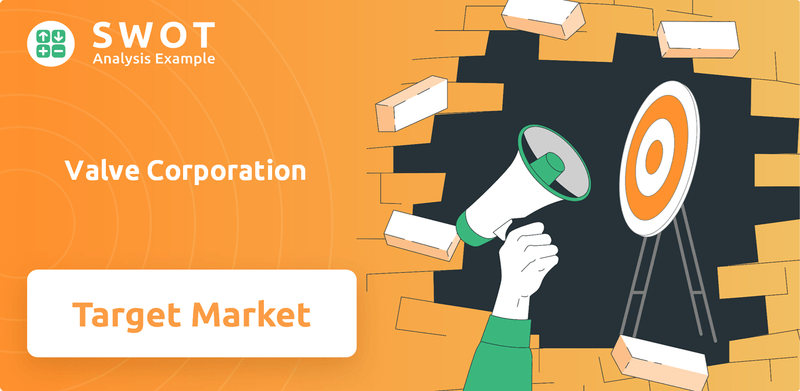
This analysis will explore the Valve Corporation SWOT Analysis, delving into the customer demographics and target market that drive Valve's success. We'll examine the Valve Company audience, including gamer profile characteristics, and how Valve adapts to the ever-changing PC gaming market. Understanding the Customer demographics and the Valve Corporation target market is crucial for any company aiming to thrive in today's competitive landscape, especially when considering the diverse interests of video game consumers across platforms.
Who Are Valve Corporation’s Main Customers?
Understanding the customer demographics and target market of Valve Corporation is key to grasping its success. The company primarily focuses on consumers (B2C) through its Steam platform and game franchises. Simultaneously, it caters to businesses (B2B) via Steamworks, offering tools for game developers. This dual approach allows Valve to capture a broad audience within the gaming industry.
The core of Valve's customer base resides on the Steam platform, a digital distribution service for video games. As of 2024, Steam boasted a substantial user base, with 132 million monthly active users (MAUs) and 69 million daily active users (DAUs). This massive user engagement indicates a diverse customer base, although PC gaming generally attracts a younger to middle-aged demographic.
While specific breakdowns of gender and income levels aren't publicly available, the gaming industry often sees a strong male presence, though female participation is growing. The company's ability to consistently attract and retain such a large user base highlights the effectiveness of its platform and game offerings. To delve deeper, you can explore a Brief History of Valve Corporation.
The Valve Corporation target market is broad, with a significant portion of users falling within the younger to middle-aged adult demographic. The gamer profile on Steam is diverse, but PC gaming leans towards a male-dominated audience, though female participation is increasing. The company has seen consistent growth in its user base, with peak concurrent users nearly doubling since March 2020.
Steam's user base has shown significant growth, reaching over 39 million peak concurrent users in December 2024, and briefly exceeding 40 million in early 2025. This growth is driven by an extensive game library and new hardware releases. The PC gaming market continues to evolve, with the company adapting to new trends like virtual reality.
The Steam Deck, released by the company, has significantly impacted user engagement. In 2024, the Steam Deck generated an impressive 330 million hours of playtime, a 64% increase from 2023. This indicates a growing segment of portable PC gamers. As the video game consumers adapt, the company continues to innovate to meet their needs.
The company has expanded its target market by venturing into virtual reality (VR) hardware with the Valve Index. The VR market is projected to reach $86.1 billion by 2025, indicating a significant growth opportunity. This expansion shows the company's commitment to staying at the forefront of technological advancements within the gaming industry.
The primary customer segments for Valve include a broad range of PC gamers, with a significant portion falling within the younger to middle-aged demographic. The company's user base is geographically diverse, with the United States being a key market. The company has adapted its strategy to cater to evolving market trends.
- PC Gamers: The core audience, drawn to the extensive game library and platform features.
- VR Enthusiasts: Targeted by the Valve Index and other VR initiatives.
- Steam Deck Users: A growing segment of portable PC gamers.
- Game Developers: Utilizing Steamworks for game distribution and development tools.
Valve Corporation SWOT Analysis
- Complete SWOT Breakdown
- Fully Customizable
- Editable in Excel & Word
- Professional Formatting
- Investor-Ready Format
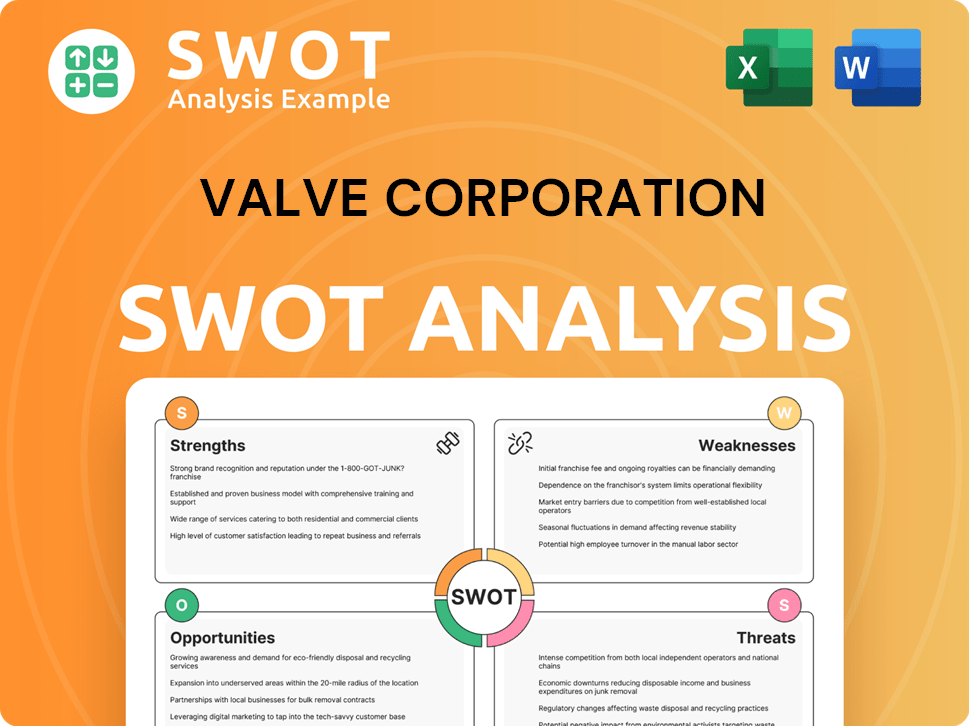
What Do Valve Corporation’s Customers Want?
Understanding the customer needs and preferences is crucial for any company's success. For Valve Corporation, this means focusing on what drives their customers, primarily centered around gaming experiences, community engagement, and platform usability. The company's approach is deeply rooted in understanding the gamer profile and the dynamics of the PC gaming market.
Valve's target market, which includes a diverse range of video game consumers, is influenced by factors like game quality, community reviews, and the availability of features. The company leverages these insights to boost user engagement and satisfaction. This customer-centric approach has been a key element in Valve's sustained growth and market position.
The purchasing behaviors of Valve's customers are significantly influenced by sales and discount events. These events are a major driver of revenue. In 2024, Steam saw a 15% increase in revenue due to seasonal sales, demonstrating the effectiveness of these promotions.
Customers seek a vast library of games. This is a core offering that attracts and retains users. The availability of diverse titles is a primary need.
Players value social interaction and community features. Multiplayer games and community forums foster engagement. This enhances the overall gaming experience.
Users expect a smooth and user-friendly platform. Features like cloud saves and automatic updates are essential. These features improve the user experience.
Customers are drawn to sales and discount events. These promotions drive immediate and post-sale revenue. Games discounted by 75% can see a 300% increase in unit sales.
Decision-making is influenced by game quality and community reviews. Positive reviews and high ratings are crucial. This affects purchasing decisions.
Features like cloud saves and workshop support are valued. These features enhance user convenience. They also extend game longevity.
Valve addresses common pain points, such as game distribution and updates, by providing automatic updates and a centralized library. Customer feedback is crucial, often channeled through Steam's community features, influencing game updates and new releases. The company tailors its marketing and product features through personalized recommendations. For more insights, you can read about the Growth Strategy of Valve Corporation.
Valve’s understanding of its customer demographics allows it to provide a tailored experience. This includes addressing the interests of Steam users and adapting marketing strategies. The following points summarize the key aspects:
- Entertainment and Social Connection: Customers seek entertainment through multiplayer games and community features.
- High-Fidelity Gaming Experiences: The desire for advanced gaming experiences, including hardware like the Valve Index, is a significant driver.
- Automatic Updates and Centralized Library: Addressing the challenges of game distribution and updates through Steam.
- Personalized Recommendations: Tailoring marketing and product features based on customer behavior analysis.
- Influenced by Sales: Purchasing behaviors are significantly influenced by sales and discount events.
Valve Corporation PESTLE Analysis
- Covers All 6 PESTLE Categories
- No Research Needed – Save Hours of Work
- Built by Experts, Trusted by Consultants
- Instant Download, Ready to Use
- 100% Editable, Fully Customizable
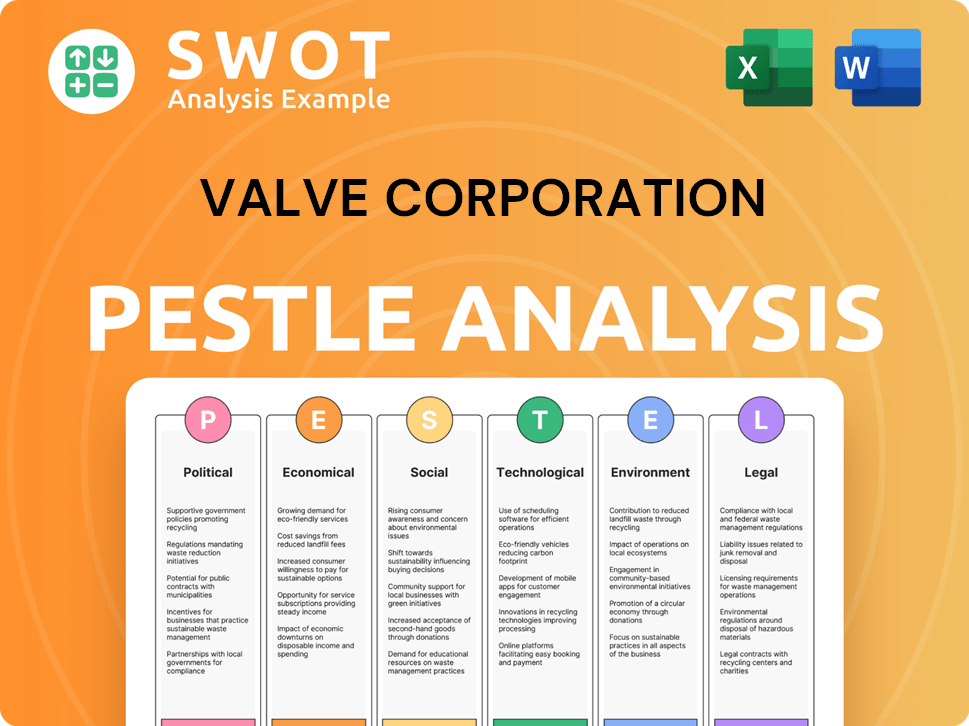
Where does Valve Corporation operate?
The geographical market presence of Valve Corporation, particularly through its Steam platform, is extensive and globally distributed. Steam's user base, which reached over 132 million monthly active users in 2024, highlights its widespread reach across numerous countries and regions. This significant user engagement underscores the platform's importance in the global gaming market.
Although Valve does not publicly disclose detailed revenue breakdowns by country, the data indicates strong market shares in key regions. For instance, China accounts for 19% of Steam traffic, and the United States represents 16.8%. These figures demonstrate the platform's substantial presence in both established and emerging gaming markets worldwide. This global footprint is a crucial element of Valve's overall business strategy.
Valve's approach to localization and marketing is crucial for its success in diverse markets. The company adapts its offerings to suit local economic conditions, such as regional pricing, and provides games in over 20 languages as of 2024. This localization strategy has contributed to a 20% increase in sales in emerging markets in 2024. This strategy allows Valve to cater to a global audience effectively.
Valve adjusts game prices based on local economic conditions, making games more affordable in various regions. This strategy helps to broaden the customer base and increase sales in markets with lower average incomes. This approach is part of Valve's broader strategy to reach a global audience.
Games are offered in over 20 languages, enabling players from different linguistic backgrounds to enjoy the content. This multilingual support is essential for reaching a global audience and ensuring that the games are accessible to a wider demographic. This is a key element of Valve's global strategy.
Valve has expanded its global outreach by translating the store user interface into numerous languages, improving its content delivery network, and incorporating new payment methods. These efforts make the platform more accessible and user-friendly for gamers worldwide. This approach is crucial for reaching a diverse customer base.
The launch of the Steam Deck in new continents has extended the platform's reach. This expansion allows Valve to tap into new markets and provide more gamers with access to its game library. This is a key part of Valve's strategy to grow its user base.
The success of developers from various countries on Steam highlights its worldwide reach. For example, a solo developer from Malaysia achieved over a million customers for their game in its first month, with the US, Australia, China, Germany, Pakistan, and Japan among the top 10 countries by units. This global success demonstrates the platform's effectiveness.
Understanding the customer demographics is crucial for Valve's success. The company's target market includes a wide range of gamers from various age groups, income levels, and geographic locations. This diverse customer base is a key factor in Valve's global success. To learn more about the competition, you can read about the Competitors Landscape of Valve Corporation.
Valve Corporation Business Model Canvas
- Complete 9-Block Business Model Canvas
- Effortlessly Communicate Your Business Strategy
- Investor-Ready BMC Format
- 100% Editable and Customizable
- Clear and Structured Layout
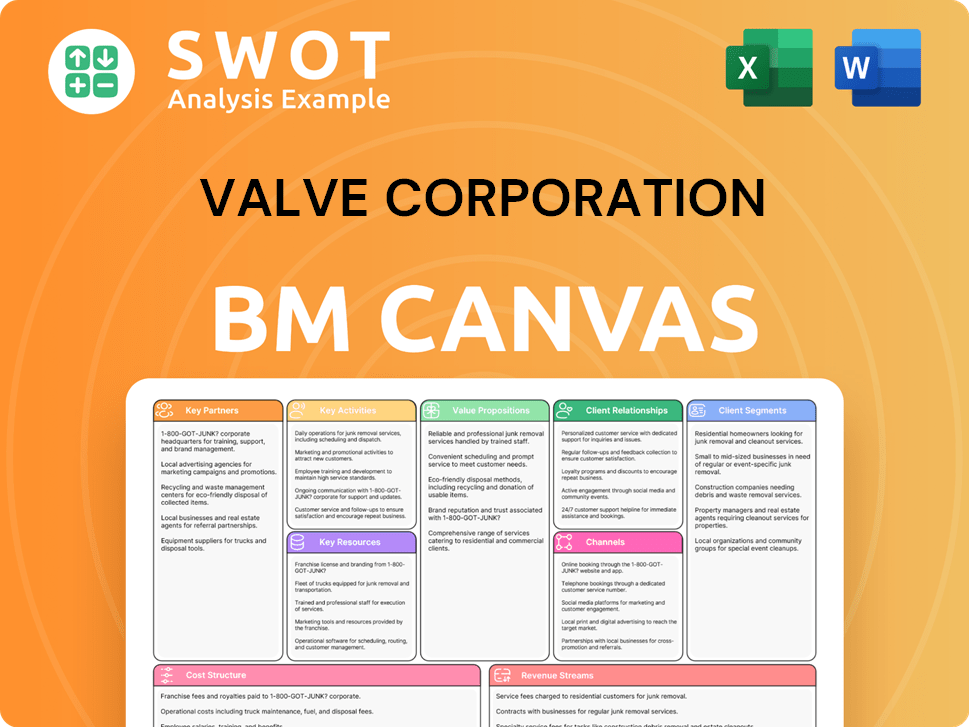
How Does Valve Corporation Win & Keep Customers?
Valve Corporation's approach to customer acquisition and retention is primarily centered around its Steam platform and a strong emphasis on community engagement. Their strategies are designed to attract new users and keep existing ones engaged. The company leverages data-driven methods to personalize user experiences and optimize marketing efforts.
A key element of Valve's acquisition strategy involves frequent sales and discount events, such as the Steam Summer Sale. These events are significant revenue drivers, attracting new users and boosting sales. Valve also focuses on improving discoverability within the Steam store, including enhanced demo displays and the Steam Next Fest events, which have made demos a more common component of pre-release marketing strategies.
For retention, Valve prioritizes consistent updates and new content for its games and the Steam platform itself. This helps foster player loyalty and encourages long-term investment in the platform. Steam's community features are vital for cultivating loyalty and allowing the customer base to influence game development and features.
Valve uses significant sales and discount events to attract new users. These events, like the Steam Summer Sale, are major revenue drivers. Games discounted by 75% experienced a 300% increase in unit sales during these events in 2024.
Valve focuses on improving discoverability within the Steam store. Enhancements include better demo displays and Steam Next Fest events. These events make demos a key part of pre-release marketing.
Steam's community features are vital for cultivating customer loyalty. These include forums, reviews, and user-generated content. The customer base can influence game development and features through these interactions.
Valve uses a data-driven approach to optimize campaigns and provide personalized game recommendations. This involves examining in-game actions and purchase histories. These efforts boost user engagement and satisfaction.
Seasonal sales in 2024 saw a 10% increase in revenue compared to 2023. This highlights the effectiveness of sales events. Such events are a major driver for attracting new customers to the platform.
The Steam Deck enhances customer loyalty by providing a versatile handheld gaming experience. This strengthens Valve's brand and increases customer retention. The Steam Deck plays a role in retaining customers.
Some reports in 2024 indicated that Steam's customer service could be difficult to access. Long wait times and unresponsive support can impact customer loyalty. Addressing these issues is important for maintaining customer satisfaction.
Valve's target market includes a broad range of gamers, from casual to hardcore. The company uses data to understand and cater to different segments within the PC gaming market. They aim to provide a diverse gaming experience.
The gamer profile on Steam varies widely, with users of different ages, income levels, and geographic locations. Valve's strategies aim to reach and retain these diverse video game consumers. The platform's success relies on this broad appeal.
Customer segmentation for Steam allows Valve to tailor offers and recommendations. This data-driven approach increases user engagement. Understanding various segments helps in creating effective marketing campaigns.
Valve Corporation Porter's Five Forces Analysis
- Covers All 5 Competitive Forces in Detail
- Structured for Consultants, Students, and Founders
- 100% Editable in Microsoft Word & Excel
- Instant Digital Download – Use Immediately
- Compatible with Mac & PC – Fully Unlocked
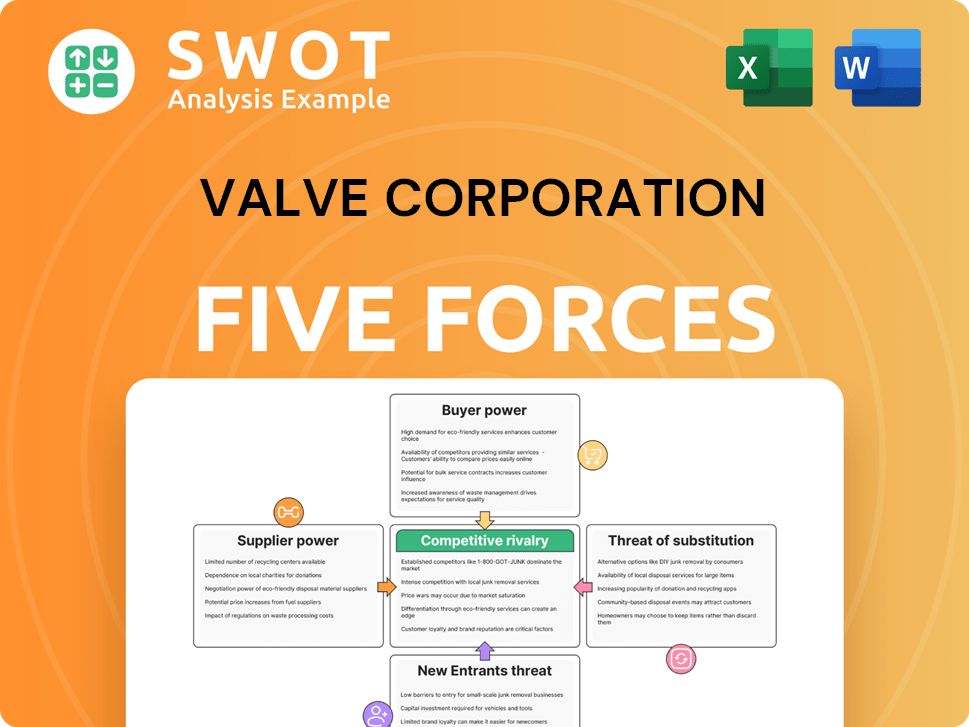
Related Blogs
- What are Mission Vision & Core Values of Valve Corporation Company?
- What is Competitive Landscape of Valve Corporation Company?
- What is Growth Strategy and Future Prospects of Valve Corporation Company?
- How Does Valve Corporation Company Work?
- What is Sales and Marketing Strategy of Valve Corporation Company?
- What is Brief History of Valve Corporation Company?
- Who Owns Valve Corporation Company?
Disclaimer
All information, articles, and product details provided on this website are for general informational and educational purposes only. We do not claim any ownership over, nor do we intend to infringe upon, any trademarks, copyrights, logos, brand names, or other intellectual property mentioned or depicted on this site. Such intellectual property remains the property of its respective owners, and any references here are made solely for identification or informational purposes, without implying any affiliation, endorsement, or partnership.
We make no representations or warranties, express or implied, regarding the accuracy, completeness, or suitability of any content or products presented. Nothing on this website should be construed as legal, tax, investment, financial, medical, or other professional advice. In addition, no part of this site—including articles or product references—constitutes a solicitation, recommendation, endorsement, advertisement, or offer to buy or sell any securities, franchises, or other financial instruments, particularly in jurisdictions where such activity would be unlawful.
All content is of a general nature and may not address the specific circumstances of any individual or entity. It is not a substitute for professional advice or services. Any actions you take based on the information provided here are strictly at your own risk. You accept full responsibility for any decisions or outcomes arising from your use of this website and agree to release us from any liability in connection with your use of, or reliance upon, the content or products found herein.